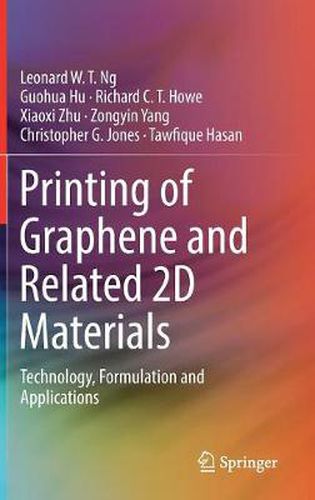Readings Newsletter
Become a Readings Member to make your shopping experience even easier.
Sign in or sign up for free!
You’re not far away from qualifying for FREE standard shipping within Australia
You’ve qualified for FREE standard shipping within Australia
The cart is loading…






This title is printed to order. This book may have been self-published. If so, we cannot guarantee the quality of the content. In the main most books will have gone through the editing process however some may not. We therefore suggest that you be aware of this before ordering this book. If in doubt check either the author or publisher’s details as we are unable to accept any returns unless they are faulty. Please contact us if you have any questions.
This book discusses the functional ink systems of graphene and related two-dimensional (2D) layered materials in the context of their formulation and potential for various applications, including in electronics, optoelectronics, energy, sensing, and composites using conventional graphics and 3D printing technologies. The authors explore the economic landscape of 2D materials and introduce readers to fundamental properties and production technologies. They also discuss major graphics printing technologies and conventional commercial printing processes that can be used for printing 2D material inks, as well as their specific strengths and weaknesses as manufacturing platforms.
Special attention is also paid to scalable production methods for ink formulation, making this an ideal book for students and researchers in academia or industry, who work with functional graphene and other 2D material ink systems and their applications.
Explains the state-of-the-art 2D material production technologies that can be manufactured at the industrial scale for functional ink formulation;
Provides starting formulation examples of 2D material, functional inks for specific printing methods and their characterization techniques;
Reviews existing demonstrations of applications related to printed 2D materials and provides possible future development directions while highlighting current knowledge gaps;
Gives a snapshot and forecast of the commercial market for printed GRMs based on the current state of technologies and existing patents.
$9.00 standard shipping within Australia
FREE standard shipping within Australia for orders over $100.00
Express & International shipping calculated at checkout
This title is printed to order. This book may have been self-published. If so, we cannot guarantee the quality of the content. In the main most books will have gone through the editing process however some may not. We therefore suggest that you be aware of this before ordering this book. If in doubt check either the author or publisher’s details as we are unable to accept any returns unless they are faulty. Please contact us if you have any questions.
This book discusses the functional ink systems of graphene and related two-dimensional (2D) layered materials in the context of their formulation and potential for various applications, including in electronics, optoelectronics, energy, sensing, and composites using conventional graphics and 3D printing technologies. The authors explore the economic landscape of 2D materials and introduce readers to fundamental properties and production technologies. They also discuss major graphics printing technologies and conventional commercial printing processes that can be used for printing 2D material inks, as well as their specific strengths and weaknesses as manufacturing platforms.
Special attention is also paid to scalable production methods for ink formulation, making this an ideal book for students and researchers in academia or industry, who work with functional graphene and other 2D material ink systems and their applications.
Explains the state-of-the-art 2D material production technologies that can be manufactured at the industrial scale for functional ink formulation;
Provides starting formulation examples of 2D material, functional inks for specific printing methods and their characterization techniques;
Reviews existing demonstrations of applications related to printed 2D materials and provides possible future development directions while highlighting current knowledge gaps;
Gives a snapshot and forecast of the commercial market for printed GRMs based on the current state of technologies and existing patents.